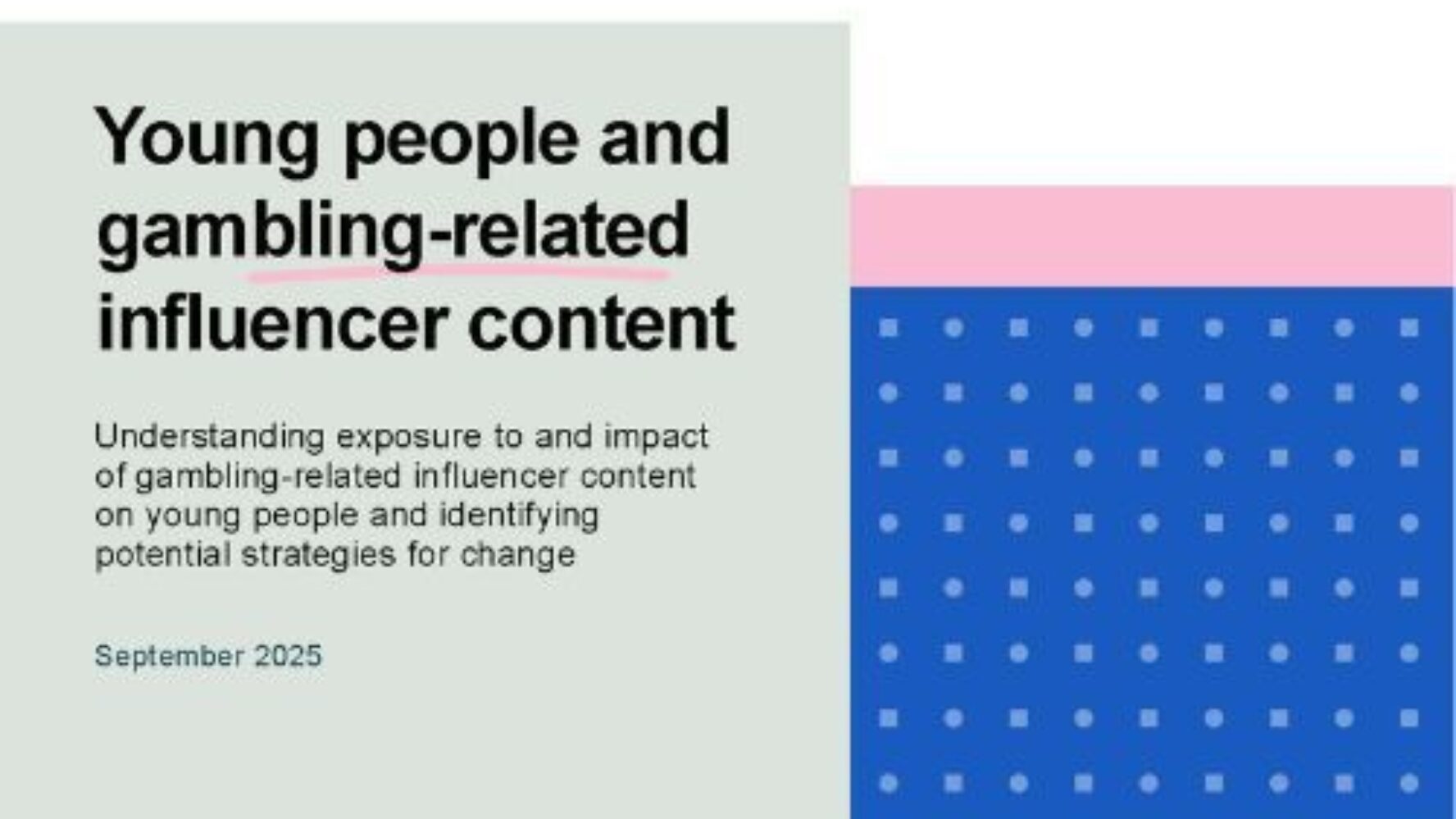

Young people and gambling-related influencer content: Social Finance's research for GambleAware

Young people linked the appeal of gambling-related influencer content to the appeal of winning “easy money” and experimenting with their financial freedom. Gambling can be portrayed as a quick and low-risk activity and this can be tempting to young people.
Young people and gambling-related influencer content, Sept 2025, p 29

Young people and gambling-related influencer content
A study carried out by Social Finance, in collaboration with Bournemouth University, YGam, GamCare and University of Sussex for GambleAware
Context to this work
The impact of the digital age on children and young people is never out of the headlines. Digital advances have made gambling increasingly accessible to children and young people in the UK, with the rapid expansion of the online gambling market exposing them to gambling products, services and materials they would not otherwise be able to access.
This is particularly concerning, as the UK Gambling Commission’s own research shows that exposure to gambling at an early age is more likely to result in children and young people displaying what would be considered problematic gambling behaviour (when recognised screening tools are applied) later in life.
This is in part due to the integration of gambling into sports and other forms of entertainment, contributing to a ‘normalisation of gambling’ that presents it as a routine, low-risk and acceptable activity.
The Diagnostic and Statistical Manual of Mental Disorders Fourth Edition — Multiple Response Juvenile (DSM-IV-MR‑J) screen has been applied to the Young People and Gambling Survey dataset to assess whether respondents who gamble are experiencing problem gambling.
A person who confirmed that they had undertaken four or more of the behaviours or actions asked about in the past year was considered a person who is experiencing ‘problem’ gambling, a score of 2 or 3 was used to identify a person experiencing ‘at-risk’ gambling and a score of 0 or 1 indicated a person who is not experiencing any ‘problems’ with their gambling.

Just over one quarter (27 percent) of 11 to 17 year olds had spent their own money on any gambling activity in the 12 months prior to completing the survey. The proportion of young people experiencing problem gambling increased from 0.7 percent in 2023 to 1.5 percent in 2024.
Young People and Gambling 2024: Official Statistics, Gambling Commission
What we did

GambleAware commissioned Social Finance, in collaboration with Bournemouth University, University of Sussex, GamCare and Ygam, to examine how children and young people experience, interpret, and are affected by, gambling-related influencer content in digital spaces.
We carried out a mixed methods approach, including a literature review, content analysis, a survey, and participatory qualitative research with children and young people over 18 months.
Our research sought to:
Understand children and young people’s level of exposure to gambling-related influencer content by quantifying the level and frequency of this across various digital platforms.
Understand the extent to which children are persuaded by this type of marketing by investigating how such content influences young people’s attitudes towards gambling and their likelihood of engaging in gambling-related behaviours.
Understand whether children and young people are able to critically evaluate gambling-related influencer content by examining whether they are able to recognise gambling-related influencer content as a form of marketing and critically assess its intent and potential harm.
Understand the most effective solutions by collaboratively designing and evaluating intervention strategies with children and young people to enhance their media literacy and reduce their susceptibility to gambling-related marketing.
Our findings


Our research revealed that children and young people are the target of highly persuasive techniques deployed by digital platforms, gambling operators, content creators, advertisers and influencers.
In addition, young people told us they feel out of control over the amount of gambling content they see and that the divisions between advertising and what they perceive to be entertainment are difficult to navigate.
Also while they express a desire to be protected, children and young people also want to be free to find their own way in digital spaces.
- CYP are regularly, and often passively, exposed to gambling-related influencer content, particularly on platforms like YouTube, TikTok, and Twitch. Algorithms amplify this exposure, especially among gamers and males or non-binary individuals.
- The majority of CYP surveyed wished to see less gambling content online, but also felt they didn’t have control over the amount of gambling content they see.
- Content creator promotions of gambling operators and games these operators host are often embedded in entertainment and framed as fun, rewarding, and socially acceptable. These messages rarely include visible risk warnings or transparent disclosures, blurring the line between advertising and content.
- Influencers’ perceived authenticity, relatability, and celebrity status enhance the persuasive power of gambling content. Interactive features and parasocial relationships contribute to the normalisation of gambling.
- CYP who follow gambling influencers were more likely to engage in high-risk behaviours such as experimenting with crypto casinos and gambling online.
- Despite some awareness of the risks, young people often place responsibility on individuals rather than platforms or advertisers and report limited access to support or trusted guidance.
- There is tension between CYP’s desire for protection from harmful content and their wish for greater autonomy in navigating digital spaces.

Many influencers positioned themselves as gambling experts to gain followers’ trust. They used insider terms like ‘parlay’ and ‘odds boost’ and offered betting tutorials, creating the illusion that gambling was skill-based rather than chance-driven.
Young people and gambling-related influencer content, Sept 2025, p 20
Our recommendations
Five ways to reduce young people’s exposure to gambling-related influencer content:
- Regulatory bodies should strengthen guidelines around clear labelling, placement and promotion of gambling-related influencer content — particularly on platforms popular with young people. This includes addressing algorithmic amplification of such content and ensuring that gambling promotions are not disguised as entertainment.
- There is a pressing need fortargeted educational interventions that build critical digital literacy and help young people recognise, question, and respond to manipulative marketing practices. These efforts should be developed in partnership with young people and embedded across schools, youth services, and digital platforms.
- Support systems — both formal and informal — must be better equipped to respond to the needs of young people who experience gambling-related harm, with a focus on reducing stigma and increasing the visibility and accessibility of youth-appropriate help.
- The design of future interventions and solutions needs to find the right balance between protecting and empowering young people. Young people want to be safeguarded where necessary, but also trusted and supported to take control of their own digital environments.
- Support further research using longitudinal and mixed-method approaches to understand the complex landscape of gambling-related influencer content and its impact on CYP, including for example more detailed research on CYP who identify as non-binary and/or research on algorithmic reinforcement of high-risk content.
Related work

Find out more
At Social Finance we work with organisations across the country to drive the systems change that keeps children and young people safe. If you want to discuss our work around online harms for children and young people please contact meg.kelly@aocialfinance.org.uk. Or if you want to find out how we can help you with your systems challenges – click on the contact us button.
Find out more


